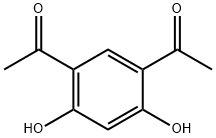Uses
1,1′-(4,6-Dihydroxy-1,3-phenylene)bisethanone (4,6-diacetylresorcinol, DAR) may be used in the synthesis of the following:
- Schiff base ligands
- hexadentate chalcogenated bisimine ligands
- 1,5-benzodiazepines
- ketimine of chitosan
- mannich bases
- hydrazone ligands
- thiosemicarbazone, semicarbazone and thiocarbohydrazone ligands
- binuclear cobalt(II) and copper(II) complexes
- europium (III) complexes
Preparation
Preparation by Friedel–Crafts acylation of resorcinol,
? with acetic anhydride,
– in the presence of zinc chloride
at 142–150° for 15 min (96%) or at 150–160° for 20 min (68%)
; – in the presence of ferric chloride
. – in the presence of concentrated sulfuric acid at 130° for 15 min (15%)
; – in the presence of 70% perchloric acid at 125–135° for 15–20 min (42%)
. ? with acetyl chloride,
– in the presence of zinc chloride, at 120°
; – in the presence of ferric chloride, at 150° for 15 min (60%) or at reflux for 30 min
; – in the presence of concentrated sulfuric acid (18%)
. ? by a typical Friedel–Crafts reaction (24%).
General Description
1,1′-(4,6-Dihydroxy-1,3-phenylene)bisethanone (4,6-diacetylresorcinol, DAR) is a bifunctional carbonyl compound. Its synthesis by acetylating resorcinol in the presence of zinc chloride has been reported. The crystal structure of DAR has been studied.

